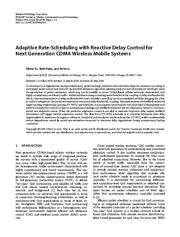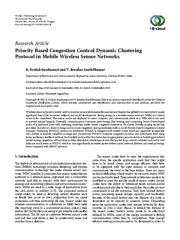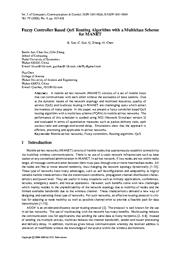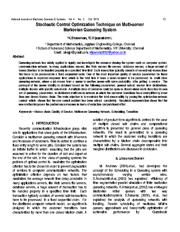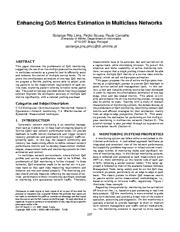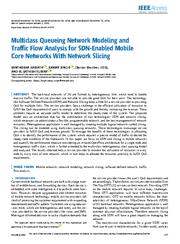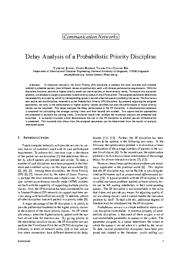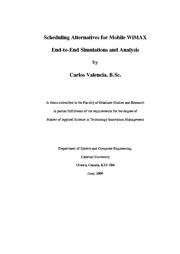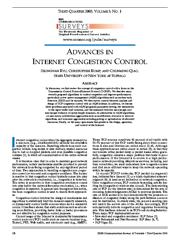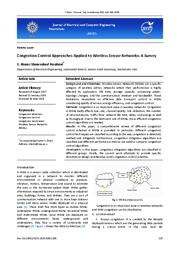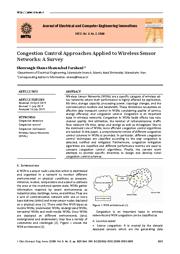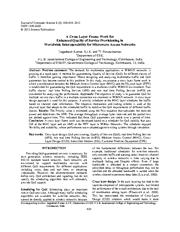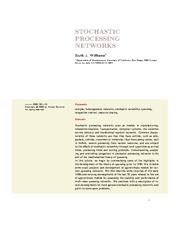A copy of this work was available on the public web and has been preserved in the Wayback Machine. The capture dates from 2017; you can also visit the original URL.
The file type is application/pdf.
Filters
Adaptive Rate-Scheduling with Reactive Delay Control for Next Generation CDMA Wireless Mobile Systems
2006
EURASIP Journal on Wireless Communications and Networking
It is an adaptive rate scheduler over multiclass CDMA systems with predictive adaptation control to adapt to nonstationary loadings; and feedback-enhanced reactive adaptation control to counteract arrival ...
To minimize QoS degradations during nonstationary packet loadings, predictive rate schedulers adapt the operation according to anticipated packet arrival rates deduced via specified estimation algorithm ...
Feedback control unit monitors average delays of each class and if it detects that a class is degraded (possibly because of estimation errors) it corrects the problem in order to achieve efficient resource ...
doi:10.1155/wcn/2006/43759
fatcat:y32jr6cgrnhhfmb6aoyunuy4ri
Priority Based Congestion Control Dynamic Clustering Protocol in Mobile Wireless Sensor Networks
2015
The Scientific World Journal
Each mobile node within the cluster has an appropriate queue model for scheduling prioritized packet during congestion without drop or delay. ...
In order to conserve energy and to avoid congestion during multiclass traffic a novel Priority Based Congestion Control Dynamic Clustering (PCCDC) protocol is developed. ...
Conflict of Interests The authors declare that there is no conflict of interests regarding the publication of this paper. ...
doi:10.1155/2015/596138
pmid:26504898
pmcid:PMC4609479
fatcat:orm3gq57ejhadoyywsadkouzuq
Fuzzy Controller Based QoS Routing Algorithm with a Multiclass Scheme for MANET
2009
International Journal of Computers Communications & Control
The performance of this scheduler is studied using NS2 (Network Simulator version 2) and evaluated in terms of quantitative measures such as packet delivery ratio, path success ratio and average end-to-end ...
Due to the dynamic nature of the network topology and restricted resources, quality of service (QoS) and multicast routing in MANET are challenging tasks which attract the interests of many people. ...
Acknowledgement The authors thank the editors and the anonymous reviewers for their valuable comments that helped to improve the paper. ...
doi:10.15837/ijccc.2009.4.2458
fatcat:j2lj2wa2zfh2nkvyp7cbox6khe
Editorial introduction
1993
Queueing systems
It discusses how one can write down a Brownian approximation to queueing networks in heavy traffic based on heuristic arguments, and justifies these arguments in the case of single class networks and multiclass ...
It focuses on the analysis of the distribution of sojourn times using Brownian approximations and offers a couple of numerical examples to illustrate how this approach can be used for performance analysis ...
Problems of service rate control, routing and admission control and scheduling are discussed. ...
doi:10.1007/bf01158926
fatcat:cvr33c7wjbgdpclctchuyiozmu
Stochastic Control Optimization Technique on Multi-Server Markovian Queueing System
2011
Indian Journal Of Applied Research
One of the most important quality of service parameters for these applications is expected response time, which is the total time it takes a users request to be processed. ...
A multiple class of customer could be open or closed where each class has its own set of queueing parameters. ...
Vijayalakshmi for their valuable support and cooperation extended to design this model in a successful way. ...
doi:10.15373/2249555x/july2013/115
fatcat:tgpj2fuqnjfifdxdpoxnvat27u
Enhancing QoS metrics estimation in multiclass networks
2007
Proceedings of the 2007 ACM symposium on Applied computing - SAC '07
This paper discusses the problematic of QoS monitoring, suggesting the use of on-line multipurpose active monitoring in multiclass networks as a powerful tool to efficiently assist and enhance the control ...
coloring to better sense packet loss. ...
For instance, while a time scale ranging from seconds to minutes is appropriate for AC, for active queue management (AQM) or packet scheduling the operating time scale varies from pico to milliseconds. ...
doi:10.1145/1244002.1244060
dblp:conf/sac/LimaSC07
fatcat:k5b25xteijbzlobl3gbbm7jd2u
Multiclass Queueing Network Modeling and Traffic Flow Analysis for SDN Enabled Mobile Core Networks with Network Slicing
2019
IEEE Access
These problems require an accurate traffic model to determine the steady-state of the system. ...
The service providers face a challenge in the efficient utilization of resources to fulfill the QoS requirement of users to comply with the growth and thereby increasing the revenue. ...
The analysis model is built with a multiclass queuing theorem where each class represents a slice or application. ...
doi:10.1109/access.2019.2959351
fatcat:7g5idtjr6bcwfb43rydaj3teke
Analysis of multiclass Markovian polling systems with feedback and composite scheduling algorithms
2011
Annals of Operations Research
We consider their application to a packet scheduling problem where multiple categories of packets share a resource. ...
Keywords Multiclass queues · Feedback · Markovian polling · Packet scheduling Introduction Multiclass queueing systems have been extensively studied to analyze packet scheduling problems in computer communication ...
Acknowledgements The author would thank the reviewers for their valuable comments which helped to improve the paper. ...
doi:10.1007/s10479-011-0910-7
fatcat:ltvz73bf3ncljow2marerqmtv4
Delay analysis of a probabilistic priority discipline
2002
Transactions on Emerging Telecommunications Technologies
In computer networks, the Strict Priority (SP) discipline is perhaps the most common and simplest method to schedule packets from different classes of applications, each with diverse performance requirements ...
To resolve this starvation problem, we propose to assign a parameter to each priority queue in the SP discipline. ...
Each class of packets has its own queue and the buffer of the queue is infinite. Packets in the same queue are served in FCFS fashion. Each queue is assigned a pa- rameter ¼ Ô ½ ½ ¾ Á . ...
doi:10.1002/ett.4460130603
fatcat:6bmtwplmlndhfh6bxxa4nve2te
Scheduling alternatives for mobile WiMAX end-to-end simulations and analysis
2010
Proceedings of the 6th International Wireless Communications and Mobile Computing Conference on ZZZ - IWCMC '10
Fourth Generation wireless technologies depend on the performance of their schedulers to deliver high data throughput and meet quality-of-service commitments. ...
We compare four schedulers for mobile WiMAX using five industry-defined key performance indicators: sector and application throughput, completion time, fairness index and delay. ...
It is up to the scheduler in each direction to sort through those queues and pick a subset of PDUs to be scheduled. ...
doi:10.1145/1815396.1815483
dblp:conf/iwcmc/ValenciaK10
fatcat:wwnzadkxzvcn3kyqiumfucda4q
Advances in internet congestion control
2003
IEEE Communications Surveys and Tutorials
Although these applications are rather elastic in nature [5] , in that they can tolerate either packet delay or packet losses rather gracefully, congestion remains a major problem that leads to poor performance ...
of queue length dynamics. ...
They proposed a general design principle: the network should manage and distribute its resources through packet scheduling and buffer management and give the best possible explicit feedback. ...
doi:10.1109/comst.2003.5342228
fatcat:exp7fdhrkjcgzedqq3grbzesky
Congestion Control Approaches Applied to Wireless Sensor Networks: A Survey
2018
Journal of electrical and computer engineering innovations
and Objectives: Wireless Sensor Networks (WSNs) are a specific category of wireless ad-hoc networks where their performance is highly affected by application, life time, storage capacity, processing power ...
Due to the dominant role of WSNs, more efficient congestion control algorithms are needed. Results: In this paper, a comprehensive review of different congestion control schemes in WSNs is provided. ...
Acknowledgement The author gratefully acknowledges the financial and other support of this research, provided by the Islamic Azad university Islamshahr branch, Islamshahr, Iran. ...
doi:10.22061/jecei.2019.5093.188
doaj:d510eeffd25d44c9b0bc925999fa7346
fatcat:35j3bupvlrda5fguadwgd7irkq
Congestion control for wireless sensor networks: A survey
2014
The 26th Chinese Control and Decision Conference (2014 CCDC)
Wireless Sensor Networks (WSNs) are a specific category of wireless adhoc networks where their performance is highly affected by application, life time, storage capacity, processing power, topology changes ...
Due to the dominant role of WSNs, more efficient congestion control algorithms are needed. In this paper, a comprehensive review of different congestion control schemes in WSNs is provided. ...
Each mobile node has a queue model to schedule prioritized packet in case of congestion without delay or drop. ...
doi:10.1109/ccdc.2014.6853042
fatcat:bnuxzouu7nay7epmk2bokb4sui
A Cross Layer Frame Work for Enhanced Quality of Service Provisioning in Worldwide Interoperability for Microwave Access Networks
2012
Journal of Computer Science
Problem statement: The demand for multimedia applications in WiMAX networks is growing at a rapid pace. ...
Hence designing and analyzing multimedia traffic and QoS parameters has become central to this problem. ...
layer and the Queue State Information (QSI) from the application layer. ...
doi:10.3844/jcssp.2012.420.424
fatcat:ln7idqvd4rd4pfbuqniv2fom4e
Stochastic Processing Networks
2016
Annual Review of Statistics and Its Application
Common characteristics of these networks are that they have entities, such as jobs, packets, vehicles, customers or molecules, that move along routes, wait in buffers, receive processing from various resources ...
, and are subject ...
for multi-class queues with feedback and for networks of multiclass queues. ...
doi:10.1146/annurev-statistics-010814-020141
fatcat:7mcq3ujtrnh4jnx63kp7xpgydy
« Previous
Showing results 1 — 15 out of 159 results

